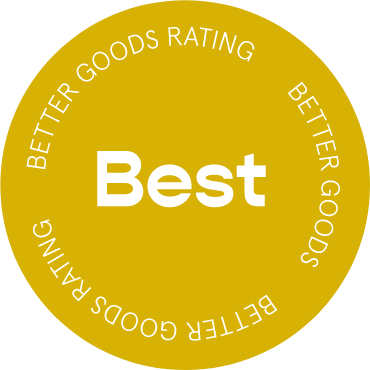The Best Organic & Natural Baby Lotions, Based on Ingredients

Over the past 2 weeks we researched 20+ of the most popular clean baby lotions (and some non-clean lotions) and rated them based on their ingredients.
Today we’ll be looking at:
- What ingredients should be avoided in baby lotions.
- Ratings for 20+ of the most popular clean baby lotions.
- How to use baby lotion the right way.
Because baby wipes are used on our children’s most sensitive areas, it’s extremely important to ensure that they’re free of toxic chemicals and irritants.
In our research, we found that many of the top brands available have chemical ingredients that are potentially toxic and dangerous. Many of them are made with polyester or plastic-based cloth derived from petroleum.
However, there are several brands available that offer a baby wipe that’s as free of toxic chemicals as possible, and some are even made from natural materials like chlorine-free wood pulp.
While it’s true that baby wipes aren’t an absolute necessity, many parents find them far too convenient to give them up.
If baby wipes are an indispensable part of your parenting repertoire, we’ll arm you with the knowledge you need to buy the best non-toxic and safe wipe.
Babies have thin, sensitive skin. This means that in the winter months and dry climates, their skin can quickly dry out. Dry skin can quickly become itchy, irritated and uncomfortable.
Baby lotion is another name for moisturizer—it’s basically baby moisturizer.
A good, clean and non-toxic baby lotion is the perfect solution to keep baby’s skin moisturized. Much like adult moisturizer, these products function by adding moisture to the skin, and keeping the existing moisture in the skin.
Our Methodology
We researched the internet, online stores and social media to find the most popular clean baby moisturizers (along with some top-selling non-clean moisturizers for comparison).
Each ingredient in every product was researched and analyzed for safety based on available public research. Where possible, sources for information are included.
Products are ranked from best to worst with an internal score based on the ingredient rankings.
Notes On Ingredients:
Irritants: Ingredients marked with an asterisk (*) are potential irritants or allergens. Unfortunately, almost all of the products we looked at contain at least one potential irritant. The most common irritants are essential oils and some alcohols.
Some baby lotions contain more harsh preservatives, namely parabens. These are toxic preservatives that have been linked to breast cancer, hormonal disruption and skin irritation. Anything ending in “-paraben” such as methylparaben, ethylparaben and butylparaben is included.
Parabens are not part of the USDA National Organic Program (NOP) list, meaning they can be included in products labeled as organic—a trick you need to watch out for. Conversely, the European Union has banned products with parabens since 2012.
As of 2020, the FDA says of parabens: “We do not have information showing that parabens as they are used in cosmetics have an effect on human health.“
Because there are products with safer alternatives, we don’t recommend using products with parabens.
Phenoxyethanol and sodium benzoate are two other preservatives found in the products we looked at. These two ingredients are safer than parabens. However, sodium benzoate is a known potential skin irritant and phenoxyethanol, which is not recommended to be used in baby products due to irritation potential.
Silicones: While this isn’t strictly an unsafe ingredient, we don’t recommend baby lotions with silicone. This is because silicone simply acts as an occlusive, meaning it seals the skin. The purpose of this is to seal in moisture, but silicones also clog the skin’s pores, which can lead to acne and irritation. Silicones are also derived from petroleum, making them decidedly a non-natural and non-eco-friendly ingredient.
Fragrance: A very common reason for skin irritation, and a 2008 study found that 83% of drugstore creams contained fragrance or a fragrance-related allergen.
The term fragrance when used in products is an umbrella term, and there are currently 3059 chemical ingredients that can be used in fragrances. And what’s worse is that manufacturers can just list “fragrance” and not the individual ingredients that go into the fragrance.
Some of these 3059 ingredients have been linked to health effects like cancer, allergies, reproductive issues and more.
We always considered non-natural fragrance as a “bad” ingredient.
A Note on Irritants
Better Goods identifies ingredients that can act as potential irritants or allergens. When it comes to baby products, this is even more of a concern, as babies have much more sensitive skin than adults.
In the ingredient listings, all irritants are marked with an asterisk (*). If you wish to avoid potential irritants, consider using a lotion that has few (or no) ingredients identified with an asterisk (*).
We reviewed 20+ of the most popular baby lotions. They’re rated on this scale:
– These products are the best of the best. They contain organic ingredients, are non-toxic and are often the best choice for our environment.
– These products are typically quite good, but don’t go above and beyond like our best choices.
– These products are typically okay, but have some issues that make us unable to give them a “Good” rating. Often times they contain ingredients that are questionable.
– These products typically have toxic ingredients or issues that make them dangerous or unsuitable to use. These products should typically be avoided.
The Best Non-Toxic Baby Lotions
The Honest Company

This is an excellent baby balm with all organic ingredients, the main ones being organic sunflower seed oil, beeswax (making it non-vegan), olive oil and shea butter. We give this product a top rating for its great list of ingredients.
Ingredients
Potential irritants: 1*
Earth Mama

Organic aloe and olive oil make up the base of this lotion. This is a non-scented lotion, and gets a top rating for the good list of non-toxic ingredients.
Ingredients
Made Of

With all-organic mix of argan, coconut, sunflower and avocado oils, along with aloe, this product gets a top rating.
Ingredients
Baja Baby
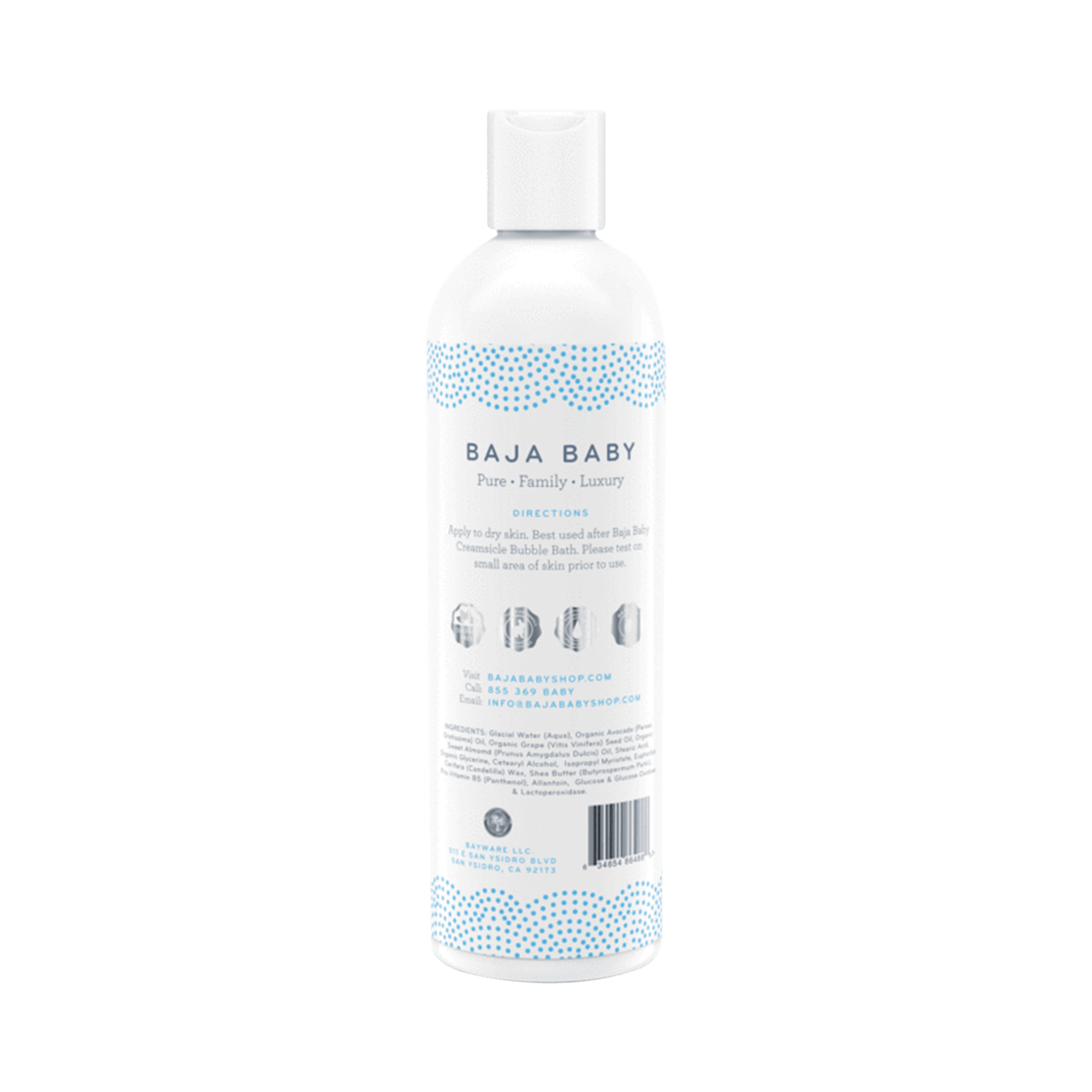
This unscented baby lotion is primarily made of water, organic avocado oil, grape seed oil and sweet almond oil.
Please note that sweet almond oil can trigger nut allergies.
Ingredients
Potential irritants: 1*
Bambo Nature

With organic ingredients including organic aloe, coconut oil, shea butter, this is a good baby lotion in terms of ingredients. It does include sodium benzoate, a preservative that some might wish to avoid, however.
Sodium benzoate is a chemical preservative. Reports show that people with sensitive skin should not use products which contain sodium benzoate as it may induce contact allergy. (source)
Ingredients
Potential irritants: 2*
Cloud Island (Target Brand)

Target’s Cloud Island lotion gets a surprisingly good rating based on ingredients. With a base of organic aloe, shea butter, cocoa butter, we give this product a top rating.
Ingredients
Non-Toxic Baby Lotions Rated “Good”
Mee Beauty

This product contains phenoxyethanol. Because this preservative can be irritating to baby’s sensitive skin, we recommend products that don’t have this ingredient over those that do.
Emulsifying wax gets an iffy rating because it can be made of either vegetable wax or a petroleum-based wax, and the exact makeup does not need to be disclosed. (source)
Phenoxyethanol is a common preservative. Typically, this ingredient is considered safe in products not meant for babies. An EU study found skin irritation in animal studies even when exposed to very low amounts. (source)
Ingredients
Potential irritants: 2*
Pipette
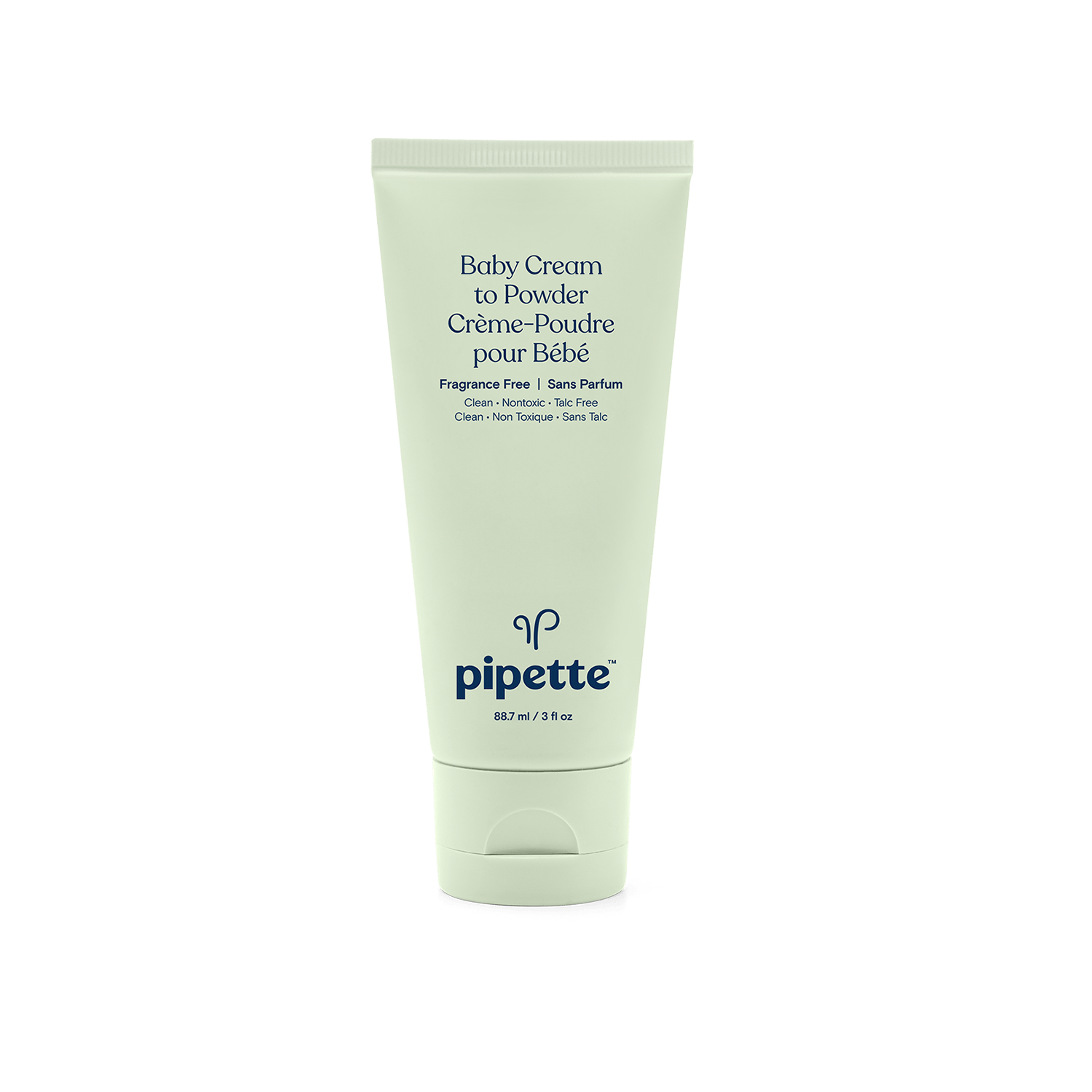
Although this isn’t an organic product, it still has a good list of ingredients. As a preservative, it uses sodium benzoate, one of the safer preservative ingredients.
Sodium benzoate is a chemical preservative. Reports show that people with sensitive skin should not use products which contain sodium benzoate as it may induce contact allergy. (source)
Ingredients
Potential irritants: 1*
Kiehl’s

Although the ingredients of this product aren’t organic, they’re still good. There are no ingredients of concern to be found.
Ingredients
Potential irritants: 2*
California Baby

This unscented lotion has no ingredients of concern. The list of ingredients is taken from the official site, but seems to be in incorrect order. The primary ingredients are likely organic aloe, canola oil, safflower seed oil and water.
Ingredients
Aleva Naturals

With many organic ingredients including aloe, shea butter and olive oil, along with no ingredients of concern, this is a safe lotion.
Ingredients
Eco By Naty

This product has a simple list of ingredients with a few of concern.
Sodium benzoate is a chemical preservative. Reports show that people with sensitive skin should not use products which contain sodium benzoate as it may induce contact allergy. (source)
Ingredients
Potential irritants: 3*
Nature's Baby Organics

The ingredients of this product show nothing of concern. While it’s not a fully organic product, the clean list of ingredients gives this product a good rating.
Sodium benzoate is a chemical preservative. Reports show that people with sensitive skin should not use products which contain sodium benzoate as it may induce contact allergy. (source)
Ingredients
Potential irritants: 1*
Babo Botanicals

This product has only one ingredient of concern, which keeps us from giving it a top rating.
There is some concern that tocopheryl acetate is at risk of being contaminated with hydroquinone, a known human carcinogen. While we believe this risk to be small, we consider tocopheryl acetate an iffy ingredient. (source)
Ingredients
Potential irritants: 1*
Little Twig

The base of this product is organic sunflower oil, octyl palmitate (derived from palm oil), aloe, and glycerin.
There are two ingredients of concern that keep us from giving this product a top rating.
There is some concern that tocopheryl acetate is at risk of being contaminated with hydroquinone, a known human carcinogen. While we believe this risk to be small, we consider tocopheryl acetate an iffy ingredient. (source)
Ethylhexylglycerin can be a mild skin and eye irritant. Extra care should be taken when using products with this ingredient around the face. (source)
Ingredients
Potential irritants: 1*
ATTITUDE
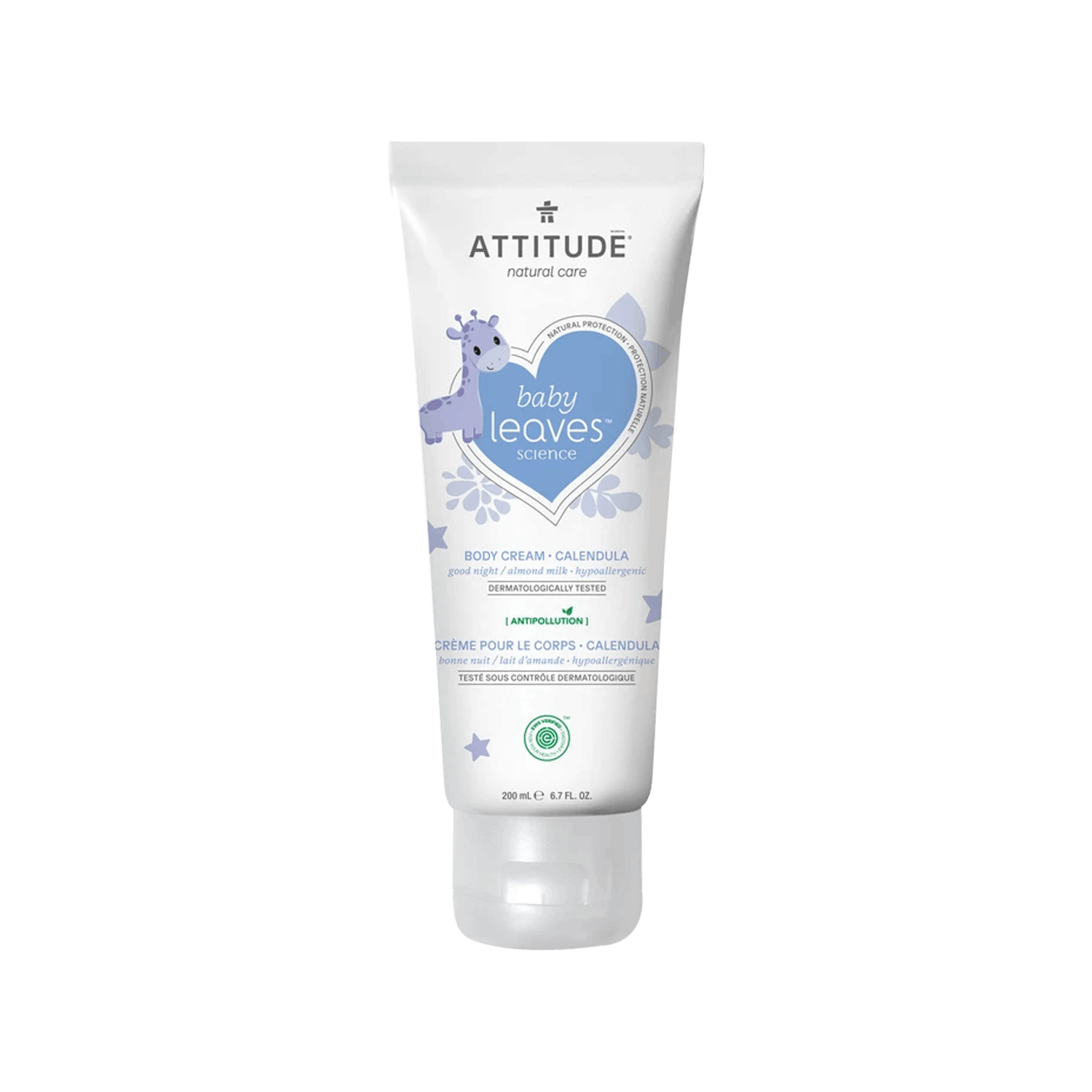
With no ingredients of concern and no potential irritants, this product gets a passing grade.
Ingredients
BabyTime

With many organic ingredients and no ingredients of concern, this product gets a good rating.
Ingredients
Potential irritants: 1*
BareBaby Organics

This baby lotion is a base of organic aloe, coconut oil, and olive oil. There is only one ingredient of concern, which keeps us from giving it a top rating.
Ethylhexylglycerin can be a mild skin and eye irritant. Extra care should be taken when using products with this ingredient around the face. (source)
Ingredients
Potential irritants: 2*
The Honest Company

Although this lotion is not organic, there are no ingredients of concern. We recommend this fragrance-free version of the lotion over the scented versions, which contain essential oils that are recognized consumer allergens.
Ingredients
Potential irritants: 1*
Babyganics

This lotion contains many organic ingredients with water, organic cocoa butter and cetyl alcohol making up the first few ingredients. There are only two ingredients of small concern.
Ethylhexylglycerin can be a mild skin and eye irritant. Extra care should be taken when using products with this ingredient around the face. (source)
Ingredients
Potential irritants: 2*
Hello Bello

This baby lotion has a large list of ingredients, but none of them are of concern besides one listed below. Many of the ingredients are organic as well.
Ingredients
Baby Lotions Rated “Iffy”
Elizabeth Parker Naturals

This balm has a great list of ingredients but has the unfortunate inclusion of tocopheryl acetate, which can be contaminated with toxic hydroquinone. While this is typically in trace amounts, we can’t recommend it over products that don’t have this danger.
There is some concern that tocopheryl acetate is at risk of being contaminated with hydroquinone, a known human carcinogen. While we believe this risk to be small, we consider tocopheryl acetate an iffy ingredient. (source)
Ingredients
Potential irritants: 1*
Era Organics

With all organic ingredients, phenoxyethanol is the only is the only ingredient of concern. Because there are other lotions with better preservatives, we give this product an iffy rating.
Emulsifying wax gets an iffy rating because it can be made of either vegetable wax or a petroleum-based wax, and the exact makeup does not need to be disclosed. (source)
Phenoxyethanol is a common preservative. Typically, this ingredient is considered safe in products not meant for babies. An EU study found skin irritation in animal studies even when exposed to very low amounts. (source)
Ingredients
Potential irritants: 3*
Weleda

While the list of ingredients in this product appears clean at first glance, there are a large number of potential allergens/irritants, which prevent us from giving it a good rating.
Ingredients
Potential irritants: 6*
Puracy

While there’s a lot to like about the ingredients list in this lotion, there are a few ingredients that prevent us from giving it a top rating.
Phenoxyethanol is a common preservative. Typically, this ingredient is considered safe in products not meant for babies. An EU study found skin irritation in animal studies even when exposed to very low amounts. (source)
Ethylhexylglycerin can be a mild skin and eye irritant. Extra care should be taken when using products with this ingredient around the face. (source)
There is some concern that tocopheryl acetate is at risk of being contaminated with hydroquinone, a known human carcinogen. While we believe this risk to be small, we consider tocopheryl acetate an iffy ingredient. (source)
Ingredients
Potential irritants: 2*
Eucerin

This product has dimethicone, a petroleum-derived ingredient in the silicones family. Silicone makes the skin feel like it’s being hydrated, but it’s simply a short-term effect. Silicones can trap debris in the pores, cause acne and congestion, and can accumulate on the skin.
Phenoxyethanol is a common preservative. Typically, this ingredient is considered safe in products not meant for babies. An EU study found skin irritation in animal studies even when exposed to very low amounts. (source)
Pentylene glycol has shown evidence of being an irritant. Studies show that it can cause contact dermatitis, which indicates that Pentylene Glycol is a sensitizing ingredient and can be considered as an allergen. (source)
Ingredients
Potential irritants: 4*
Cetaphil

While none of the ingredients are of high concern in this product, we prefer products with more natural ingredients.
Perfume is a blanket term that hides the exact chemical makeup of the fragrance used in this product. We never recommend products that have chemical fragrance: read here for a full explanation.
Propylene glycol acts as a penetration enhancer, increasing skin absorbtion of other ingredients in a product. When none of the other ingredients in a product is potentially dangerous, this isn’t a concern. (source)
Ingredients
Potential irritants: 3*
Shea Moisture

There is some concern that tocopheryl acetate is at risk of being contaminated with hydroquinone, a known human carcinogen. While we believe this risk to be small, we consider tocopheryl acetate an iffy ingredient. (source)
Ingredients
Potential irritants: 2*
Little Twig

There is some concern that tocopheryl acetate is at risk of being contaminated with hydroquinone, a known human carcinogen. While we believe this risk to be small, we consider tocopheryl acetate an iffy ingredient. (source)
Ethylhexylglycerin can be a mild skin and eye irritant. Extra care should be taken when using products with this ingredient around the face. (source)
Ingredients
Potential irritants: 1*
Fifi & Friends

While this product has a relatively short list of ingredients, we count a total of 6 potential allergens/irritants, and therefore recommend avoiding this product.
Perfume is a blanket term that hides the exact chemical makeup of the fragrance used in this product. We never recommend products that have chemical fragrance: read here for a full explanation.
Sodium benzoate is a chemical preservative. Reports show that people with sensitive skin should not use products which contain sodium benzoate as it may induce contact allergy. (source)
Pentylene glycol has shown evidence of being an irritant. Studies show that it can cause contact dermatitis, which indicates that Pentylene Glycol is a sensitizing ingredient and can be considered as an allergen. (source)
Urea is a penetration enhancer, meaning it will increase the dermal absorption of other ingredients. This is typically not an issue unless there are other ingredients of concern in a product. (source)
Ingredients
Potential irritants: 6*
Seventh Generation

This product contains several fragrance ingredients considered by the European Union’s Scientific Committee on Consumer Safety (SCSS) to be at high risk of causing contact allergy. Because this is a lotion meant for babies, we don’t recommend this product.
The EU’s SCSS considers jasmine flower extract to be an ingredient of high concern of causing allergic contact dermatitis. (source)
The EU’s SCSS considers sweet orange oil to be an ingredient of high concern of causing allergic contact dermatitis. (source)
The EU’s SCSS considers limonene to be an ingredient of high concern of causing allergic contact dermatitis. (source)
Ingredients
Potential irritants: 2*
TotLogic

We recommend avoiding this product for the reasons stated below.
Benzyl alcohol is listed by the The European Union’s Scientific Committee on Consumer Safety (SCCS) as a well-recognized consumer allergen. (source)
Phenoxyethanol is a common preservative. Typically, this ingredient is considered safe in products not meant for babies. An EU study found skin irritation in animal studies even when exposed to very low amounts. (source)
Ethylhexylglycerin can be a mild skin and eye irritant. Extra care should be taken when using products with this ingredient around the face. (source)
Ingredients
Potential irritants: 2*
Baby Lotions Rated “Bad”
Aquaphor

Although this product has a short list of ingredients, it’s primarily a petroleum jelly and mineral oil product. These ingredients are occlusive, meaning they seal the skin to keep moisture from leaving. However, they’re synthetic (petroleum-derived) and can clog pores. For this reason, we recommend a product with natural ingredients over one with petroleum jelly.
Ingredients
Mustela

With many non-natural ingredients and chemical fragrance, we don’t recommend this product.
Perfume is a blanket term that hides the exact chemical makeup of the fragrance used in this product. We never recommend products that have chemical fragrance: read here for a full explanation.
There is some concern that tocopheryl acetate is at risk of being contaminated with hydroquinone, a known human carcinogen. While we believe this risk to be small, we consider tocopheryl acetate an iffy ingredient. (source)
Polysorbate 60 can be contaminated with ethylene oxide and 1,4-dioxane, possible human carcinogens.
Ingredients
Potential irritants: 2*
Johnson & Johnson

With synthetic fragrance—which can use hundreds of potentially toxic chemicals—along with phenoxyethanol and sodium hydroxide, we can’t recommend this lotion.
Phenoxyethanol is a common preservative. Typically, this ingredient is considered safe in products not meant for babies. An EU study found skin irritation in animal studies even when exposed to very low amounts. (source)
The ingredient “fragrance” means that there is a mixture of several essential oils or synthetic or natural chemicals that makeup the scent of the product. According to European and US legislation, the ingredients of the fragrance do not have to be revealed on the product’s ingredients list. Because these ingredients are not disclosed, we always consider this a “bad” ingredient.
Ethylhexylglycerin can be a mild skin and eye irritant. Extra care should be taken when using products with this ingredient around the face. (source)
Ingredients
Potential irritants: 2*
Johnson & Johnson

Our biggest issue with this lotion is the inclusion of fragrance, phenoxyethanol, and tocopheryl acetate. The latter ingredient can be contaminated with hydroquinone, a known carcinogen.
While some of the other ingredients are overtly toxic, we prefer to avoid silicones (dimenthicone) and disodium EDTA which can act as a penetration enhancer, leading to more of the toxic ingredients to be absorbed into the body.
There is some concern that tocopheryl acetate is at risk of being contaminated with hydroquinone, a known human carcinogen. While we believe this risk to be small, we consider tocopheryl acetate an iffy ingredient. (source)
This product has dimethicone, a petroleum-derived ingredient in the silicones family. Silicone makes the skin feel like it’s being hydrated, but it’s simply a short-term effect. Silicones can trap debris in the pores, cause acne and congestion, and can accumulate on the skin.
Ethylhexylglycerin can be a mild skin and eye irritant. Extra care should be taken when using products with this ingredient around the face. (source)
Phenoxyethanol is a common preservative. Typically, this ingredient is considered safe in products not meant for babies. An EU study found skin irritation in animal studies even when exposed to very low amounts. (source)
The ingredient “fragrance” means that there is a mixture of several essential oils or synthetic or natural chemicals that makeup the scent of the product. According to European and US legislation, the ingredients of the fragrance do not have to be revealed on the product’s ingredients list. Because these ingredients are not disclosed, we always consider this a “bad” ingredient.
Ingredients
Potential irritants: 3*
Eucerin

We don’t recommend this product for the following reasons.
PEG-40 Stearate can be contaminated with 1,4-dioxane and ethylene oxide, a possible human carcinogen and known human carcinogen respectively.
Phenoxyethanol is a common preservative. Typically, this ingredient is considered safe in products not meant for babies. An EU study found skin irritation in animal studies even when exposed to very low amounts. (source)
Ethylhexylglycerin can be a mild skin and eye irritant. Extra care should be taken when using products with this ingredient around the face. (source)
Benzyl alcohol is listed by the The European Union’s Scientific Committee on Consumer Safety (SCCS) as a well-recognized consumer allergen. (source)
Ingredients
Potential irritants: 3*
CeraVe

We recommend avoiding this product for the reasons listed below.
This product has dimethicone, a petroleum-derived ingredient in the silicones family. Silicone makes the skin feel like it’s being hydrated, but it’s simply a short-term effect. Silicones can trap debris in the pores, cause acne and congestion, and can accumulate on the skin.
Phenoxyethanol is a common preservative. Typically, this ingredient is considered safe in products not meant for babies. An EU study found skin irritation in animal studies even when exposed to very low amounts. (source)
A study found a link between behentrimonium methosulfate and possible reproductive toxicity in mice. (source)
There is some concern that tocopheryl acetate is at risk of being contaminated with hydroquinone, a known human carcinogen. While we believe this risk to be small, we consider tocopheryl acetate an iffy ingredient. (source)
Polysorbate 60 can be contaminated with ethylene oxide and 1,4-dioxane, possible human carcinogens.
Ethylhexylglycerin can be a mild skin and eye irritant. Extra care should be taken when using products with this ingredient around the face. (source)
Ingredients
Potential irritants: 2*
Dove
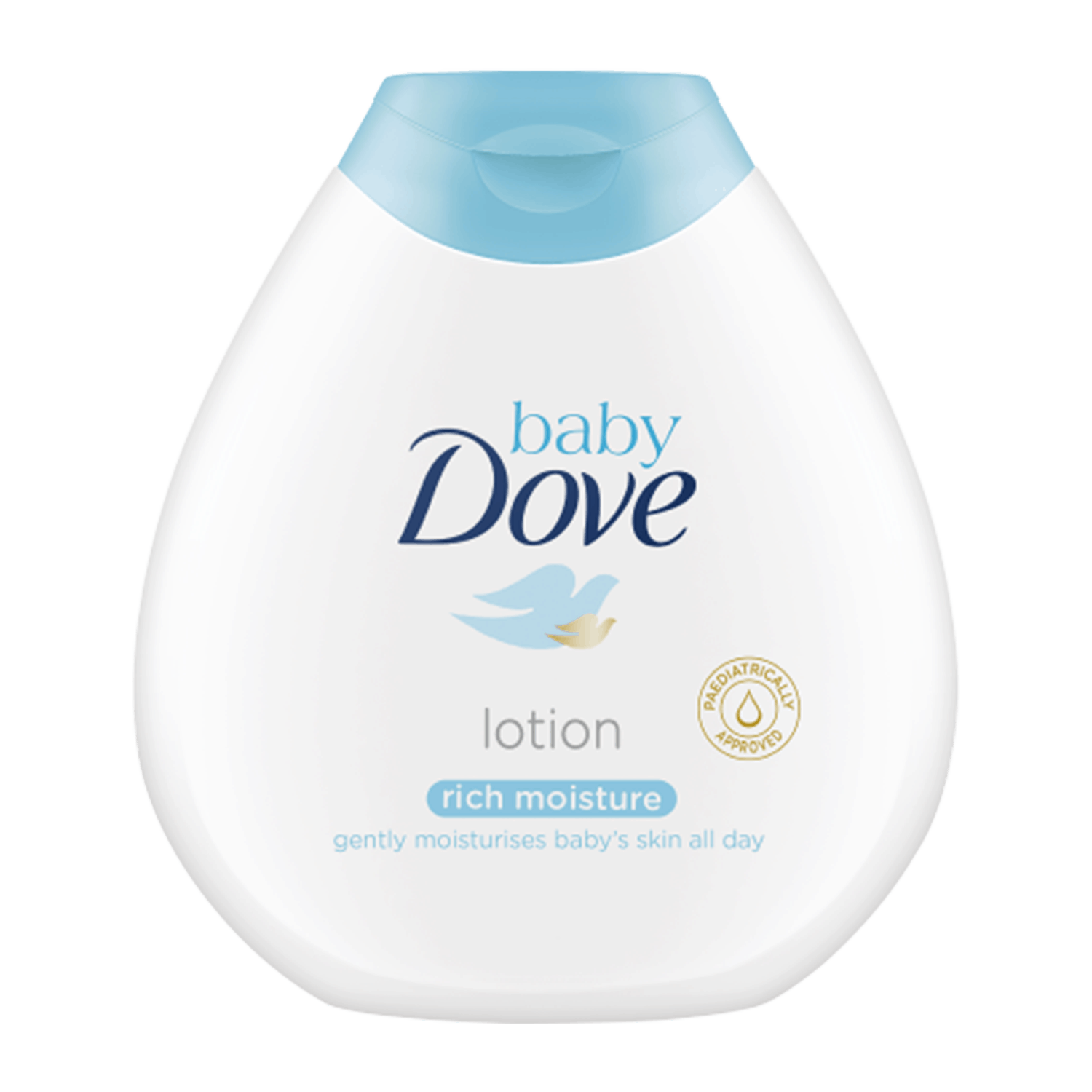
This lotion uses triethanolamine, chemical fragrance, and phenoxyethanol. For these reasons, we recommend avoiding it.
This product has dimethicone, a petroleum-derived ingredient in the silicones family. Silicone makes the skin feel like it’s being hydrated, but it’s simply a short-term effect. Silicones can trap debris in the pores, cause acne and congestion, and can accumulate on the skin.
Triethanolamine (TEA) has been shown to be carcinogenic in animal studies. (source)
Phenoxyethanol is a common preservative. Typically, this ingredient is considered safe in products not meant for babies. An EU study found skin irritation in animal studies even when exposed to very low amounts. (source)
The ingredient “fragrance” means that there is a mixture of several essential oils or synthetic or natural chemicals that makeup the scent of the product. According to European and US legislation, the ingredients of the fragrance do not have to be revealed on the product’s ingredients list. Because these ingredients are not disclosed, we always consider this a “bad” ingredient.
Ingredients
Potential irritants: 3*
Burt's Bees Baby

We take issue with a few ingredients in this lotion.
The lactic acid in the lotion is the biggest thing that gives us pause. While this ingredient is often used in skincare as a chemical exfoliant, we feel that it has no place in a product for use on a baby’s delicate skin.
In skincare products with lactic acid, you’re recommended to wear sunscreen after use because it increases sensitivity to UV rays.
Because of this, we can’t recommend this product.
Sodium benzoate is a chemical preservative. Reports show that people with sensitive skin should not use products which contain sodium benzoate as it may induce contact allergy. (source)
Phenoxyethanol is a common preservative. Typically, this ingredient is considered safe in products not meant for babies. An EU study found skin irritation in animal studies even when exposed to very low amounts. (source)
Ingredients
Potential irritants: 3*
Vaseline

This cream is a laundry list of bad ingredients. With multiple types of parabens, petroleum jelly, PEG-100 and tocopheryl acetate (which can be contaminated with toxins), this product should be nowhere near you or your baby.
PEG-100 Stearate can be contaminated with 1,4-dioxane and ethylene oxide, a possible human carcinogen and known human carcinogen respectively.
Phenoxyethanol is a common preservative. Typically, this ingredient is considered safe in products not meant for babies. An EU study found skin irritation in animal studies even when exposed to very low amounts. (source)
This product contains one or more parabens. These are preservative linked to endocrine disruption and is associated with the proliferation of breast cancer cells. (link)
Ingredients
Potential irritants: 3*
When To Apply Baby Lotion
This is a simple question with a simple answer: the best time to moisturize your baby’s skin is right after bath time. This helps trap the moisture from the bath in baby’s skin.
It might seem counterintuitive, but frequent baths can actually dry the skin out. Soaps remove the natural oils from baby’s skin, causing it to dry out.
Applying baby lotion regularly in the winter months is also a good idea. When the air in your home is cool and dry, it can dry out baby’s skin as well.

